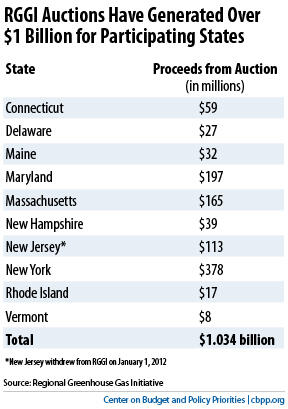BEYOND THE NUMBERS
Global warming may be off Congress’ radar screen for now, but a group of northeastern states have operated coordinated cap and trade programs to “put a price” on carbon pollution since 2008 through the Regional Greenhouse Gas Initiative (RGGI). RGGI raised over $40 million last week in its sixteenth auction of permits to emit carbon dioxide; these auctions have raised more than $1 billion (see table).

RGGI is a useful reminder that we can raise revenue while achieving other important policy goals.
Each of the nine states participating in RGGI has set a cap on the pollution that electric power plants may release. Electricity producers must hold a permit for each ton of carbon dioxide pollution they emit.
States distribute most of the permits through quarterly auctions. States have used this revenue for a variety of purposes, including investing in energy efficiency and renewable energy, helping poor families pay their energy bills, and shrinking state budget shortfalls.
Furthermore, RGGI estimates that the coordinated programs will cut carbon dioxide pollution in the region by 10 percent by 2018.
At the federal level, too, raising revenues by limiting carbon dioxide pollution could help address two of our most pressing long-term concerns. As we have discussed, federal policymakers should take a balanced approach to reducing long-term deficits that includes both spending cuts and revenue increases. They should consider a carbon pollution tax or some other mechanism that puts a price on carbon pollution as a potential revenue source in this package.
